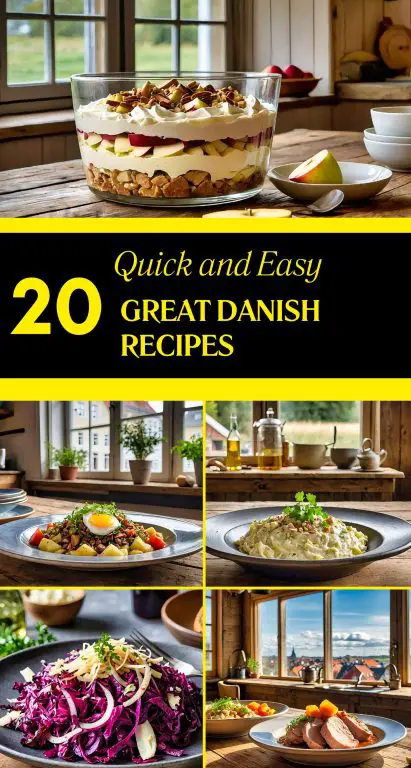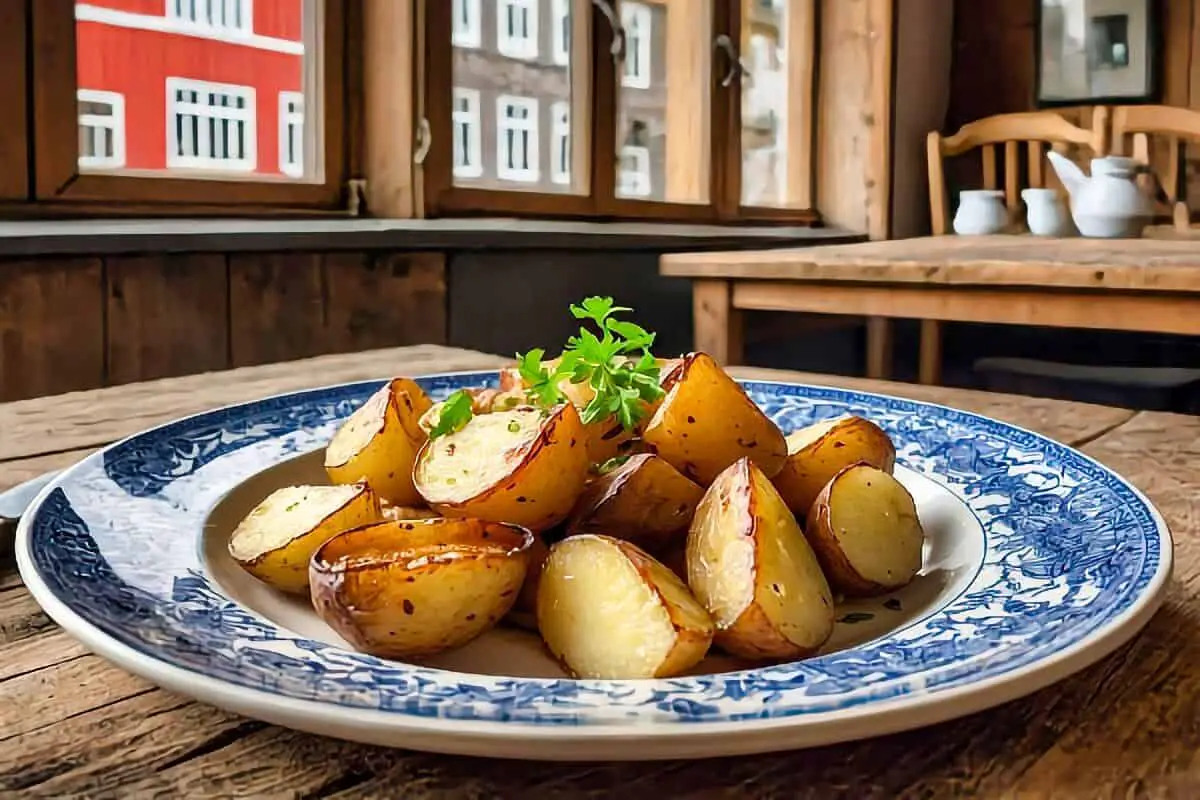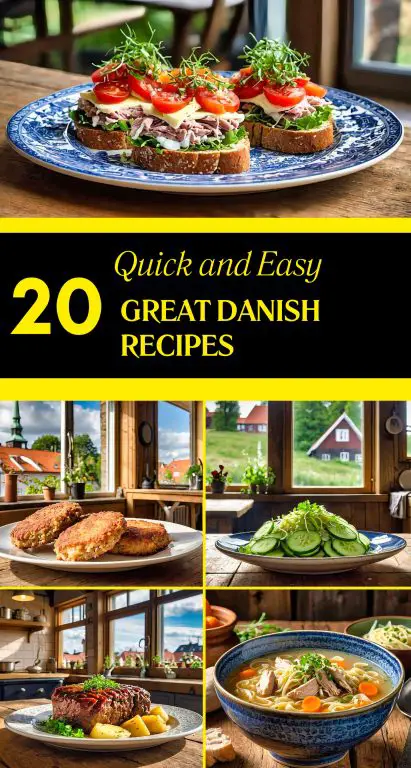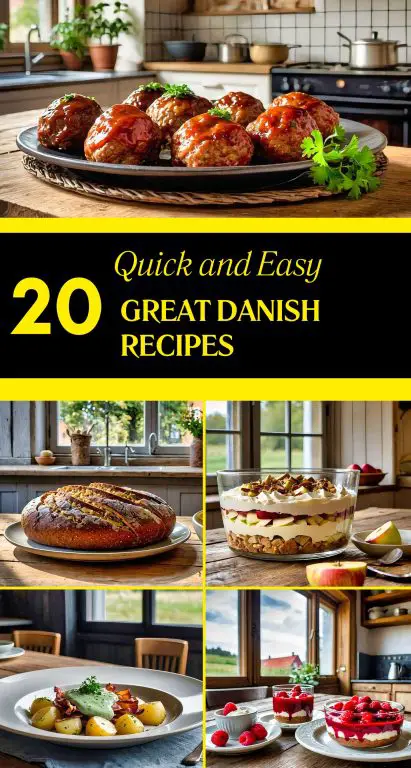The Danish Brunede Kartofler recipe was the focus of the cooking class I took in Randers, Denmark. Randers is a town located in the central part of Denmark, known for its vibrant mix of modern and historical attractions.
The town’s picturesque streets are lined with traditional Danish architecture, and places like the Randers Regnskov, an indoor rainforest zoo, offer a unique experience. The town also boasts a number of cultural sites, including the Memphis Mansion, which is dedicated to Elvis Presley, and the Randers Art Museum, showcasing Danish art.
As for the Danish Brunede Kartofler, this dish is a staple in Danish cuisine, often served during the Christmas season or special family gatherings. The dish consists of small, boiled potatoes that are caramelized in sugar and butter. The result is a rich, glossy, and slightly crispy exterior with a soft, creamy interior. I was excited to learn how to prepare this dish as it is both simple and beloved by locals.
The first impression of the Danish Brunede Kartofler was its sweetness and richness. The potatoes, which are typically small and waxy, absorb the butter and sugar, creating a subtle caramelized coating. The texture was a combination of crispy and soft, with the outer layers offering a slight crunch while the inside remained fluffy. The dish is often served as a side to meat-heavy dishes like roast pork or beef, and it perfectly complements these mains with its sweet contrast.
I also learned during the class that Danish Brunede Kartofler is an essential part of festive meals in Denmark. Locals enjoy this dish as a comforting side, especially when paired with other traditional dishes such as Danish Stegt Flæsk med Persillesovs. The preparation of the potatoes in sugar and butter is a simple yet effective technique that enhances the potatoes’ natural flavour, making them a popular choice at holiday meals and gatherings in Randers.
Overall, the Danish Brunede Kartofler was easy to make and incredibly tasty. I could see why it is so popular in Randers, and I could imagine it being a familiar and comforting dish for many locals. It’s a dish that perfectly balances sweetness and texture, making it a memorable addition to any meal

Ingredients
2 Lb New Potatoes , choose small ones that are uniform in size
1/4 Cup granulated sugar
2 Tbsp butter
Cooking Instructions
- Pick tiny, uniformly sized potatoes that are firm and waxy. Avoid overcooking by boiling the skins on in salted water until done.
- After the skins have cooled enough to handle, but are still warm (this facilitates peeling), remove them. Even though brunede kartofler are simple to create, this part takes patience and time. It will be well worth it in the end, so keep going!
- Chill the potatoes for at least a few hours in the refrigerator. They are best served chilled the night before.
Browning Sugar
- While swirling occasionally to avoid burning, melt the sugar in a cast-iron skillet over medium heat. Browning will occur when the sugar melts. Wait for it to turn a deep golden brown. Melt the butter by adding it and stirring constantly. When the sugar and butter have melted together, add the cooled potatoes.
- Give everything a good stir to coat them evenly. If the sugar does begin to crystallize, don’t fret; it will simply melt back down. After coating the potatoes with the sugar glaze, let them cook until they are gently browned, stirring regularly. The amount of browning you do is a question of taste, but I enjoy my potatoes with a little crust.
The Favorite Food of Danish Locals
Denmark is a country celebrated for its rich food heritage, with a focus on fresh, local ingredients and traditional cooking methods. Danish cuisine has gained international recognition, but the local favourites often revolve around comforting, everyday dishes that reflect the simplicity and quality of Nordic food culture.
Smørrebrød: The Iconic Open-Faced Sandwich
Denmark’s most popular dish is an open-faced sandwich on rye bread called Smørrebrød. This staple may be topped with pickled herring and cured meats, shrimp, or eggs, or seasonal vegetables. Danish locals enjoy smrrebrd for lunch or on special occasions. Rye bread (rugbrd) is one of the main dishes in Danish cuisine, prized for its thick, nutty taste.
Frikadeller: A Family Favorite
Frikadeller are Danish meatballs that are seasoned with onion, salt, pepper and allspice in the hearts of ground pork, beef or veal. They are pan-fried to golden perfection with boiled potatoes, creamy gravy and pickled red cabbage. Frikadeller are a staple at family dinners and are loved for their softness and comforting appeal.
Rugbrød: The Foundation of Danish Meals
Rugbrød is dense, dark rye bread, a cultural staple. It is a staple food for Danish locals, packed with nutrients and fibre. Often paired with cold cuts, cheese, or fish, rugbr’d is celebrated for its rich flavor and versatility. Some Danes make their very very own bread at home.
Flæskesteg: A Festive Delight
Flæskesteg (roasted pork with crispy crackling) is a traditional Christmas dish in Denmark. This traditional dish calls for pork loin seasoned with salt and sometimes cloves and roasted for crackling. It is served with caramelised potatoes, red cabbage and savoury gravy and is a traditional dish of Danish hospitality and cuisine.
Danish Pastries: A Sweet Treat
Danish pastries wienerbrød remain a local favorite, although internationally known. From custard-filled spandauerto jam-topped tebirkes, these buttery, flaky delights come in many shapes and flavors. They are usually eaten with a cup of coffee during the afternoon break kaffepause.
Hygge on a Plate
Danish food is strongly associated with Hygge, cosiness and contentment. Meals are often simple but prepared with care, using seasonal and quality ingredients. Whether it’s a light lunch of smørrebrød or a festive dinner with flæskesteg, Danish locals value food, family and tradition.
Every bite in Denmark is a story of heritage, community and respect for the land. For visitors, tasting these favourite dishes is a delicious way to taste the heart of Danish culture.
How to Find Local Food Favorites in Denmark
Copenhagen, Denmark’s vibrant capital, is a hub for culinary exploration, blending traditional Nordic dishes with modern food trends. For visitors looking to experience the best local food spots, the key lies in seeking out places that prioritise fresh, seasonal ingredients and authentic Danish flavours. While the city offers numerous high-end restaurants, including several Michelin-starred establishments, some of the most memorable dining experiences can be found at more casual and locally loved spots.
One of the best ways to uncover Copenhagen’s food gems is by exploring the city’s bustling food markets. Torvehallerne, an indoor food market located in the heart of Copenhagen, is a treasure trove of Danish delicacies. Here, you’ll find vendors selling everything from traditional *smørrebrød* (open-faced sandwiches) to freshly baked pastries like *kanelsnegle*. For a truly local experience, try sampling fresh fish or locally crafted cheeses. These markets also provide the opportunity to interact with the vendors, who often have great recommendations for nearby hidden gems.
Walking through the city’s diverse neighbourhoods is another effective way to find authentic food experiences. Nørrebro, known for its multicultural flair, offers a range of eateries serving both traditional Danish fare and creative fusion cuisine. Meanwhile, the Christianshavn neighbourhood boasts charming canalside cafes where you can enjoy classic dishes like *frikadeller* (Danish meatballs) or *flæskesteg* (roast pork with crackling).
If you prefer guided insights, consider joining a local food tour. Many tours in Copenhagen focus on showcasing the city’s culinary highlights, often including visits to lesser-known spots that tourists might overlook. These tours are an excellent way to sample a variety of Danish foods while learning about their history and significance.
Social media and review platforms like Instagram and TripAdvisor can also point you toward popular local favourites. Look for posts and reviews from locals rather than tourists to get authentic recommendations. Many Copenhagen residents share their dining experiences online, making it easier to discover hidden treasures off the beaten path.
Don’t overlook Copenhagen’s bakeries and coffee shops, which are an integral part of Danish food culture. Iconic pastries like *wienerbrød* (Danish pastries) are best enjoyed fresh from a neighbourhood bakery. Pairing a pastry with a cup of strong Danish coffee at a cosy cafe offers a quintessentially Danish experience.
Last, be open to asking locals for advice. Danes are known for their friendliness and will often be happy to share their favourite dining spots. Whether it’s a bartender at a craft beer bar or the cashier at a local market, their recommendations can lead you to some of the most authentic meals in Copenhagen.
By combining market exploration, neighbourhood walks, guided tours, and local advice, you can immerse yourself in Copenhagen’s vibrant food scene. These efforts not only ensure you’ll find the best local food spots but also deepen your understanding and appreciation of Danish cuisine.
FAQ For the Danish Brunede Kartofler Recipe
Q: How does the Danish Stegt Flæsk med Persillesovs recipe compare to the Danish Brunede Kartofler recipe?
While the Danish Stegt Flæsk med Persillesovs recipe features crispy pork belly with a creamy parsley sauce, the Danish Brunede Kartofler is a sweet potato dish made by caramelizing boiled potatoes in sugar and butter. Both dishes are popular in Denmark, but the Brunede Kartofler recipe is a side dish, while the Stegt Flæsk is a main course.
Q: Can the Danish Brunede Kartofler recipe be made ahead of time?
Yes, you can prepare the Danish Brunede Kartofler recipe ahead of time by boiling the potatoes and storing them. When ready to serve, simply caramelize them in sugar and butter. The Danish Stegt Flæsk med Persillesovs recipe, however, is best served fresh to maintain the crispiness of the pork belly.
Q: What type of potatoes are best for the Danish Brunede Kartofler recipe?
Waxy potatoes, such as new potatoes, are ideal for the Danish Brunede Kartofler recipe as they hold their shape well and provide the perfect balance between softness and crispiness when caramelized. If you’re also preparing the Danish Stegt Flæsk med Persillesovs recipe, potatoes can be served alongside to complement the meal.
Q: Is Danish Brunede Kartofler commonly served in Denmark?
Yes, Danish Brunede Kartofler is a common dish in Denmark, especially during the holiday season and festive gatherings. It is often served as a side dish alongside meats such as roast pork, similar to the way the Danish Stegt Flæsk med Persillesovs recipe is served with potatoes and parsley sauce.
Q: How do you serve the Danish Brunede Kartofler with the Danish Stegt Flæsk med Persillesovs recipe?
The Danish Brunede Kartofler recipe can be served alongside the Danish Stegt Flæsk med Persillesovs recipe. The sweet caramelized potatoes pair nicely with the savoury pork belly and creamy parsley sauce, balancing the richness of the main dish with a hint of sweetness from the potatoes.

Danish Brunede Kartofler Recipe
Ingredients
- 2 Lb Potatoes New Potatoes - choose small ones that are uniform in size
- 1/4 Cup sugar granulated
- 2 Tbsp butter
Instructions
- Pick tiny, uniformly sized potatoes that are firm and waxy. Avoid overcooking by boiling the skins on in salted water until done.
- After the skins have cooled enough to handle, but are still warm (this facilitates peeling), remove them. Even though brunede kartofler are simple to create, this part takes patience and time. It will be well worth it in the end, so keep going!
- Chill the potatoes for at least a few hours in the refrigerator. They are best served chilled the night before.
- Browning Sugar
- While swirling occasionally to avoid burning, melt the sugar in a cast-iron skillet over medium heat. Browning will occur when the sugar melts. Wait for it to turn a deep golden brown. Melt the butter by adding it and stirring constantly. When the sugar and butter have melted together, add the cooled potatoes.
- Give everything a good stir to coat them evenly. If the sugar does begin to crystallize, don't fret; it will simply melt back down. After coating the potatoes with the sugar glaze, let them cook until they are gently browned, stirring regularly. The amount of browning you do is a question of taste, but I enjoy my potatoes with a little crust.




4 comments
Sweet tasty side dish from Denmark.
I cant believe they didnt mention the secret spice mix used in Brunede Kartofler! Its the key to its unique flavor. Who else agrees that the spice blend is crucial? Lets discuss!
I personally think that the key to making the perfect Danish Brunede Kartofler lies in the caramelization process. Its all about that sweet, sticky goodness that makes it irresistible! Whos with me on this cooking secret?
I personally think the secret ingredient in Brunede Kartofler is the love and care put into caramelizing those potatoes. Who needs fancy spices when you have pure Danish passion in the mix?